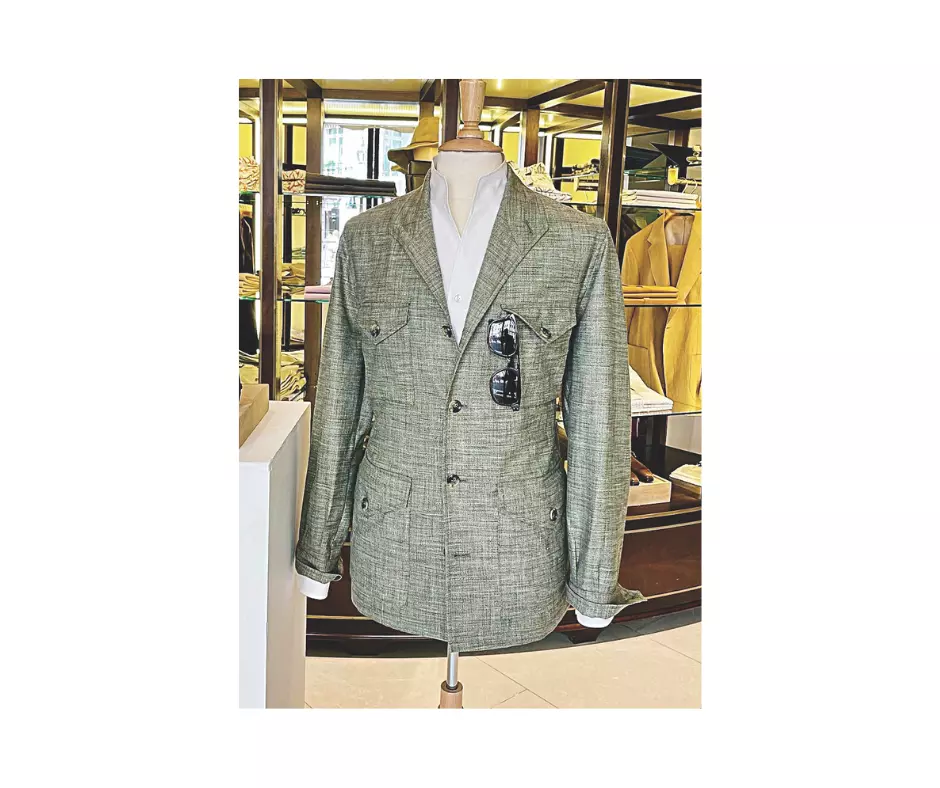Fashion World Goes Bananas Over Pineapple

Suit made out of bamboo fibre. (Image by arrangement)
The world of fashion is witnessing a ‘spike’ in fruity make-overs. Pineapple leather, or Piñatex, is revolutionizing the world of sustainable fashion. This eco-friendly alternative to traditional leather is not only stylish but also makes your wardrobe a little bit zestier. Piñatex, the zesty, eco-friendly alternative to traditional leather is making office attire fruitier and cooler across the world. ‘’It’s a cruelty-free material, reducing the demand for livestock farming, which is a significant contributor to deforestation and greenhouse gas emissions,’’ says Chaitsi Ahuja founder and CEO of Brown Living.
Green Leather
Crafted from pineapple leaves—typically discarded after harvest—this innovative material offers an eco-friendly alternative to traditional leather. According to data from the Global Fashion Agenda (2022), pineapple leather's production results in a 75% reduction in carbon footprint and uses 50% less water compared to conventional leather.
The market for such sustainable materials is booming, with the Grand View Research (2023) predicting a 12% annual growth rate through 2030. This rise is driven by a growing consumer demand for eco-conscious products. Pineapple leather not only repurposes agricultural waste but also provides new income streams for farmers, making it a win-win for the environment and the fashion industry.
“Around 480 leaves go into the creation of a single square meter of Piñatex, which weighs and costs less than a comparable amount of leather,” says Urmi Daga, a fashion influencer based in Mumbai.
Pineapple Perfection
Pineapple leather is turning heads in the fashion world.
Pineapple Perfection
Pineapple leather is turning heads in the fashion world.
This vegan, eco-friendly material is made from the fibres of pineapple leaves—yes, the ones that usually get tossed out in the trash bin after harvesting. Instead of going to waste, these leaves can be transformed into fabric that looks and feels like leather but is far kinder to the planet.
Here’s how it works: the leaves are stripped down to their fibres, which are then processed into a non-woven mesh. This mesh is treated to become a flexible, durable, and leather-like material. The result? A stylish alternative to leather that skips the environmental and ethical pitfalls of animal hides and synthetic plastics. Why is pineapple leather causing such a stir? It’s a brilliant case of upcycling—turning trash into treasure.
By repurposing waste, it not only cuts down on what gets thrown away but also gives pineapple farmers a new source of income, especially in developing countries. Plus, it’s way more eco-friendly than traditional leather. The production process uses much less water, doesn’t involve nasty chemicals, and has a lower carbon footprint. And the cherry on top? Pineapple leather is biodegradable, unlike synthetic leathers that hang around in landfills for ages.
"Piñatex remains a more sustainable option than pure PU or traditional animal leather."— Chaitsi Ahuja, founder & CEO, Brown Living
"I love my pineapple leather bag! It’s not just a fashion statement—it’s a statement about who I am and what I care about.”— Priya Chopra, homemaker cum Piñatex convert
Go Green With Envy
Lotus Fibre Sustainability: Uses plant parts that are otherwise discarded, reducing waste.
The exact percentage of waste reduction varies but is significant compared to traditional fibres.
Water Use: Minimal compared to conventional fibres. Exact percentages are not widely documented but are generally considered much lower.
Chemical Use: Very low, as the production process is quite natural.
"Around 480 leaves go into the creation of a single square meter of Piñatex.” — Urmi Daga, fashion influencer, Mumbai
Pineapple Fibre Waste Reduction: Uses 40% of the pineapple plant that would otherwise be discarded.
Water Use: Much lower than traditional leather production, though specific percentages are not well documented.
Chemical Use: Minimal, with an eco-friendly processing method compared to synthetic alternatives.
Water Use: Much lower than traditional leather production, though specific percentages are not well documented.
Chemical Use: Minimal, with an eco-friendly processing method compared to synthetic alternatives.
Fine-Apple Findings
• 75% reduction in carbon footprint in pineapple leather production
• 50% less water consumed compared to conventional leather
• Piñatex (pineapple leather) products include mobile covers, waist belts, shoes, jackets, caps, and gloves among other things
• 75% reduction in carbon footprint in pineapple leather production
• 50% less water consumed compared to conventional leather
• Piñatex (pineapple leather) products include mobile covers, waist belts, shoes, jackets, caps, and gloves among other things
( Source : Deccan Chronicle )
Next Story
